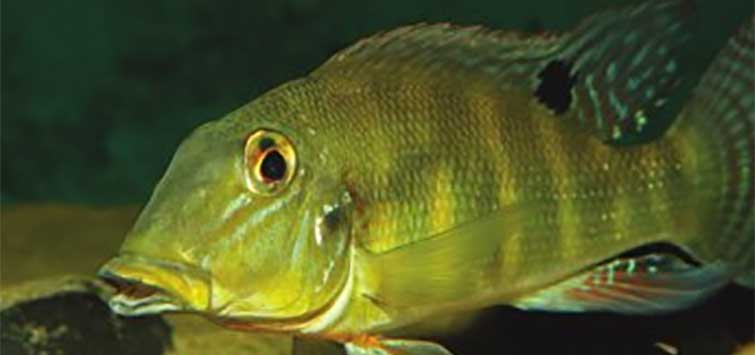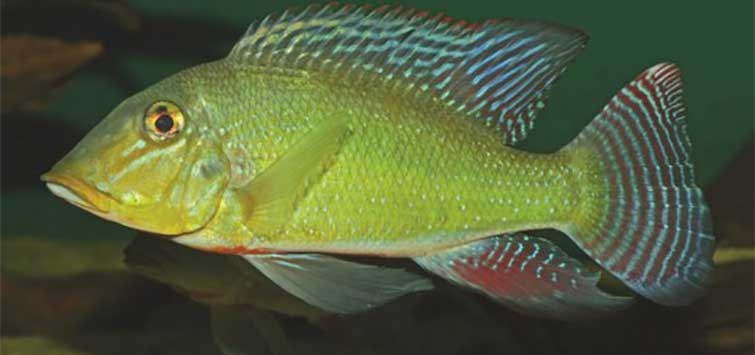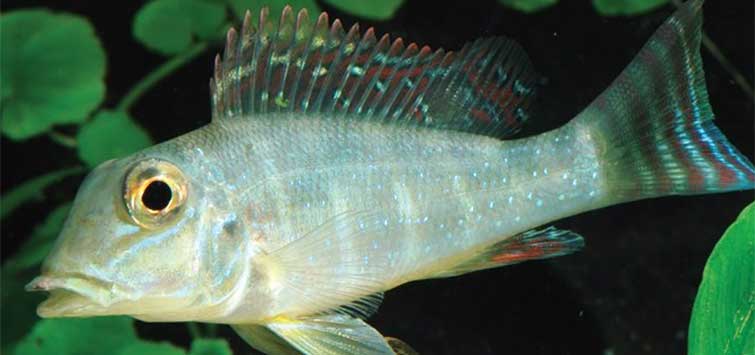Thinking Outside the Glass Box: A First Time Spawning of Retroculus xinguensis
Author: Wayne S. Leibel PhD
In my last column (TFH September 2007), the third in this series about innovative aquaristics, I introduced the three species of the little-known (to the hobby) genus Retroculus. In a nutshell, there are three species recognized by science: R. lapidifer (Castelnau 1855), R. xinguensis Gosse 1971, and R. septentrionalis Gosse 1971. The first two species are found in the rapids of the Brazilian rivers Rios Araguaia/Tocantins and Rio Xingu respectively. Retroculus septentrionalis hails from the Rio Oyapock in French Guiana. The first two Brazilian species have been imported sporadically into the aquarium hobby since the early 1990s. It will probably take a trip by dedicated aquarists to introduce the third species.
Finding a Formula for Success
For now what is important is to know that all Retroculus are rheophilic cichlids found in the rapids and that they have inflexible requirements of clean, well-oxygenated water. They have posed both exportation/shipping and husbandry challenges because of these specific needs and this, in part, accounts for their relative scarcity in the cichlid hobby. I have had them twice and lost them both times after a relatively long period of seeming “happiness” in my setup.
I have yet to find the formula for their successful long-term maintenance, let alone the one for spawning them. I won’t even buy them anymore. And, as of the year 2000, according to Weidner in his magnificent eartheater reference South American Eartheaters (Cichlid Press, English translation), no one had yet gotten free-swimming fry from these fish. Eggs, but no fish. I had not seen any spawning reports from either side of the Atlantic in the six years since the publication of that book. Retroculus species remained another “unspawnable” cichlid.
Retroculus in the Newman Cichlid Aquarium
Not surprisingly, Lee Newman was smitten by the Retroculus bug—it was love at first challenge! This quickly became an obsessional target for him, but the initial difficulty lay in simply acquiring wild stock.
When Lee finally had the opportunity in October 2003 to acquire Retroculus xinguensis from our friend, importer Oliver Lucanus (Below Water) of Montreal, Canada, he jumped at the chance. The punchline here: by June 2006, after several unsuccessful spawnings that had started in February of that year, Lee finally had free-swimming fry. And the key that unlocked the secret was, in retrospect, a simple one: pebbles (and exemplary husbandry). You can read about his experiences yourself in the January 2007 issue of Cichlid News (16 [1]: 6-12) accompanied by his excellent photographs, if you can get a copy. What follows is the condensed version of that account with Lee’s innovative approach in highlight.
Lee received 10 specimens of R. xinguensis, about 2.4 to 2.8 inches in total length, and first quarantined them in a 50-gallon tank. He fitted the quarantine tank with an oversized power filter and vigorously bubbling box filter to meet their demands for clean, moving, highly-oxygenated water. He maintained the pH at 6.0 to 6.8 and the temperature at 81° to 84°F. He cleaned the filter and changed about 75 percent of the water every 7 to 10 days. The aquarium had fine sand and some small stones for perching. (They often “hop” rather than swim, hence my own coined common name of “goby eartheater” back in the early 1990s, even though Kullander has more recently suggested they are not closely related to eartheaters.)
Diet
Given Lee’s experience with Satanoperca acuticeps, where diet was the key (see my August 2007 TFH column), he turned to the scientific literature to research what Retroculus species ate in the wild. According to Moreira and Zuanon (2002, “Dieta de Retroculus lapidifer, peixe reofilico do rio Araguaia.” Acta Amazonica 32:691-705), both R. lapidifer and R. xinguensis feed primarily on aquatic larvae of chironomids (midges), trichopterids (caddisflies) and ephemeropteroids (mayflies).
So, frozen bloodworms (midge larvae) became a staple of their diet, along with frozen brine shrimp and a homemade gelatin-based food composed of green peas and shrimp, the same food that had proven successful in the case of S. acuticeps. A few months later, the 10 fish were moved to a 180-gallon (72 x 24 x 24) tank, set up like the quarantine tank and already housing five S. leucosticta eartheaters. Maintenance and feeding continued as above, and the two species prospered together with no problems.
Moving Tanks
In November of 2004, Lee moved the 10 fish to a 300-gallon (96 x 30 x 24) tank, set up and maintained as above. Their tankmates varied and included either S. leucosticta or another eartheater, G. brachybranchus. By April of 2004, eight months after receiving them, the Retroculus had grown to approximately 4.5 to 6.7 inches in total length. A dominance hierarchy became established, with the largest, most brightly colored fish (presumably a male) as the dominant fish. Lee witnessed the onset of courtship-like behavior including reciprocal lateral displays and fin flaring.
Spawning
In February of 2006 (30 months; 2½ years after receiving the fish), courtship intensified and included pit digging. In March, the largest fish and another large specimen dug an 8-inch diameter depression in the sand and pasted their eggs directly on the sand. The eggs were large, ovoid, and adhesive, and were quickly coated in sand. When finished, after some 30 to 40 minutes, the pair picked up the sand-covered eggs and placed them in a pile next to a small stone. Within an hour, the other tank residents had quickly eaten the eggs. Lee removed some of the fish from the tank to presumably deal with this problem, and about one month later the male spawned with another female, but again the other fish (now only four others) ate the eggs.
Lee then removed the other four individuals and housed only the pair in the 300-gallon tank. In early May, the pair spawned again. They again picked up their sand-coated adhesive eggs and placed them in a pile next to a large rock. They uncovered, recovered, and moved the eggs several times over the course of the next four days, but the eggs did not hatch and the adults resumed their normal, non-spawning behavior. Others had gotten this far: Weidner (2000) published photos of the eggs coated in sand. But none had ever hatched.
The Key to Success
And now the key to final success: free-swimming fry. A drum roll please…can you say “lapidifer,” err…”stone bearer”? The species name lapidifer, chosen by de Castelnau (1855) for the fish he first described, means “stone bearer.” This refers to an interesting behavior—and one of the keys, as it turns out, to their successful captive spawning—reported by de Castelnau in his original description. His type specimen, which he collected from the rapids of the Rio Araguaia in Brazil, was observed transporting small pebbles one by one in its mouth, then using them to construct a nest for its eggs (Gosse, 1971).
In early June, Lee added several handfuls of small pebbles to the sand substrate. He chose them on the basis of their density, so the adults would be able to manipulate/carry them. Within a day of adding the pebbles, the adults began picking up and moving them.
More Spawning
About a week after the pebbles were added, the pair spawned again. Again they spawned in a shallow depression directly on the sand, but this time the eggs were gathered up and placed in a previously made pile of pebbles. The pile had been constructed by the adults on the bare floor of the aquarium after all the sand had been removed from the site. The eggs fell in the spaces between the pebbles and were not visible. The female hovered over the pile and fanned the eggs vigorously with her pectoral fins while the male guarded the perimeter. They exchanged roles only occasionally and then only briefly. The adults excavated another area of bare aquarium floor and moved their pebble pile plus eggs to the new location. They moved the pile one more time and then left it until—3½ days post-spawning—the eggs hatched! The female hovered, mouthing and spitting above the pile of pebbles; she was tending her wrigglers.
Fry
Upon free-swimming, the fry were offered newly hatched brine shrimp (Artemia). Rather than take them from the water column, the fry converged on a spot where the adults were “blowing” into the sand (much like angelfish or discus sometimes do to feed). It seemed that the blowing behavior moved the sand and exposed food organisms for the fry. It was not until their second day of free swimming that the fry took the swimming Artemia nauplii. At night, the fry were tucked safely amongst the pebbles by their parents only to emerge the next day when the lights came on.
At about two weeks post-spawning, the fry had become highly mobile and the pebble nest was abandoned. Lee siphoned off most of the 200 to 250 fry and moved them to a rearing aquarium. He left about 60 fry with the parents. At about three weeks the adults began exhibiting courtship behaviors again. He was able to successfully rear and distribute his F1 Retroculus xinguensis, increasing the chances that this very beautiful and interesting cichlid will be available in the hobby as potentially more easily managed tank-reared stock. Meanwhile, he has successfully spawned his Retroculus xinguensis several more times, indicating that his initial success wasn’t just luck.
The Moral of the Story
That a particular fish remains “unspawnable” in our aquaria simply means that we are missing one or more crucial environmental components they need to ripen eggs, be stimulated to spawn, and complete the reproductive process. In all cases we must give them what they need. And, often times, when the tried and true formulaic approach is not working, we must ourselves determine what the missing ingredient or the missing catalyst is. What do they need? And what aren’t they getting? To answer these questions we must be ready to learn all we can about our target fish—where it comes from and how it lives—and then apply that knowledge. And we must apply that information experimentally, persistently, and patiently.
I have called it the “DOPE” principle in previous columns. To succeed with “unspawnable” fish one must be Determined, Obsessive, Persistent (and patient), and Experimental. One must be willing to think outside of the glass box and be willing to try new approaches methodically and persistently until the particular species yields its secrets.
My friend Lee Newman clearly, as demonstrated by his first time spawnings of both Satanoperca acuticeps (TFH August 2007) and Retroculus xinguensis which had heretofore resisted all attempts at captive propagation, is an inspirational example of what a “good” aquarist is all about—someone willing to learn and experiment and go the extra mile to keep and spawn those challenging fish that defy lazy fishkeeping. Lee Newman clearly is one who thinks out of the glass box and turns that strategy to his aquaristic advantage. Meanwhile, his latest crop of Satanoperca lilith is beginning to court! I’m willing to bet he will succeed this time.
See the full article on TFH Digital http://www.tfhdigital.com/tfh/200710/#pg48

.png?h=595&iar=0&w=2781&hash=5FD5E69473BCC22199FBFA2FB71B6033)



